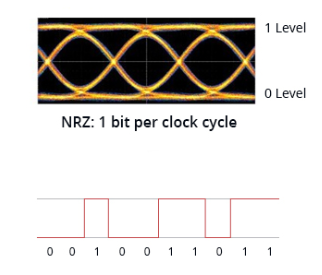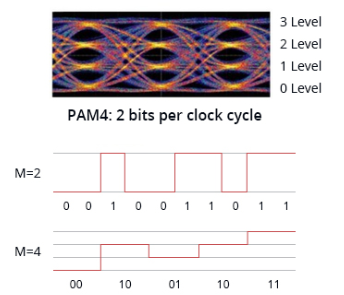
PAM4 (Pulse Amplitude Modulation 4) is used to convert digital data into analog signals. In 400G Ethernet, PAM4 is used to convert digital data into optical signals for transmission in optical fibers. PAM4 technology represents 4 different digital states by changing the amplitude and phase of the optical signal, each state representing 2 bits of data. Compared with traditional NRZ (Non-Return-to-Zero) modulation technology, PAM4 can transmit more data under the same bandwidth, thereby increasing the data transmission rate. In 400G Ethernet, PAM4 technology is widely used for data transmission between optical modules and optical fibers.
AM4 advantages:
1. Improve bandwidth utilization: PAM4 has twice the throughput of NRZ at the same baud rate, so it can increase network bandwidth without adding additional optical fibers, effectively improving bandwidth utilization.
2. Reduce signal loss: PAM4 allows twice the amount of information to be transmitted in each symbol period than NRZ, so at the same code rate, the baud rate (symbol rate) of PAM4 is only half that of the NRZ signal, thus reducing signal transmission signal loss in. This advantage enables PAM4 to use existing channels and interconnects for higher bit rates without increasing channel losses.
3. Reduce the demand for optical devices: PAM4 uses a high-order modulation format, which can reduce the number of optical devices used and reduce the performance requirements for optical devices, thereby reducing costs.
4. Suitable for embedded DWDM networks: PAM4 optical modules can be directly used in switches of embedded DWDM networks, providing cost-effective and simple solutions for customers building embedded DWDM data networks.
PAM4 disadvantages:
1. Transmission distance limitation: PAM4 optical modules require the use of amplifiers to transmit over 5km, and a separate DWDM multiplexer is required to be equipped with dispersion compensation and amplifiers, which increases the complexity and cost of the system.
2. Affected by noise interference: PAM4 is susceptible to noise interference. Its additional voltage level requirements reduce the level interval, resulting in the need for a higher signal-to-noise ratio, especially in long-distance transmission and noisy environments, affecting signal quality. .
3. Small vertical eye diagram opening: The vertical eye diagram opening of the PAM4 signal is small, making it more sensitive to noise and resulting in a higher bit error rate. However, PAM4 is possible because forward error correction (FEC) can help the system achieve the required bit error rate.
4. Increased energy consumption: In order to reduce the bit error rate in the PAM4 channel, equalization needs to be performed at the receiving end and pre-compensation at the transmitting end. This will increase additional power consumption and heat generation, causing the energy consumption of the PAM4 transceiver to increase.
NRZ (Non-Return-to-Zero) and PAM4 (Pulse Amplitude Modulation 4) are two different modulation technologies used to convert digital data into analog signals for transmission in optical fibers. They differ in bitrate and signal loss.
PAM4 uses 4 different signal levels for signal transmission. Each symbol period can represent 2 bits of logical information (0, 1, 2, 3), that is, there are four levels in one unit of time. Therefore, at the same baud rate, the throughput of PAM4 is twice that of NRZ. In other words, PAM4 can increase network bandwidth without adding additional optical fibers, effectively improving bandwidth utilization.


Bit rate: NRZ technology represents 2 different digital states by changing the amplitude of the optical signal, each state representing 1 bit of data. Compared with PAM4 technology, it represents 4 different digital states by changing the amplitude and phase of the optical signal, each state representing 2 bits of data. Therefore, PAM4 technology can transmit more data under the same bandwidth, thereby achieving higher bit rates.
Signal loss: NRZ technology may suffer from signal loss during transmission because the amplitude of the optical signal may be weakened by noise and attenuation. PAM4 technology represents 4 different digital states by changing the amplitude and phase of the optical signal, so it can better resist noise and reduce the possibility of signal loss.